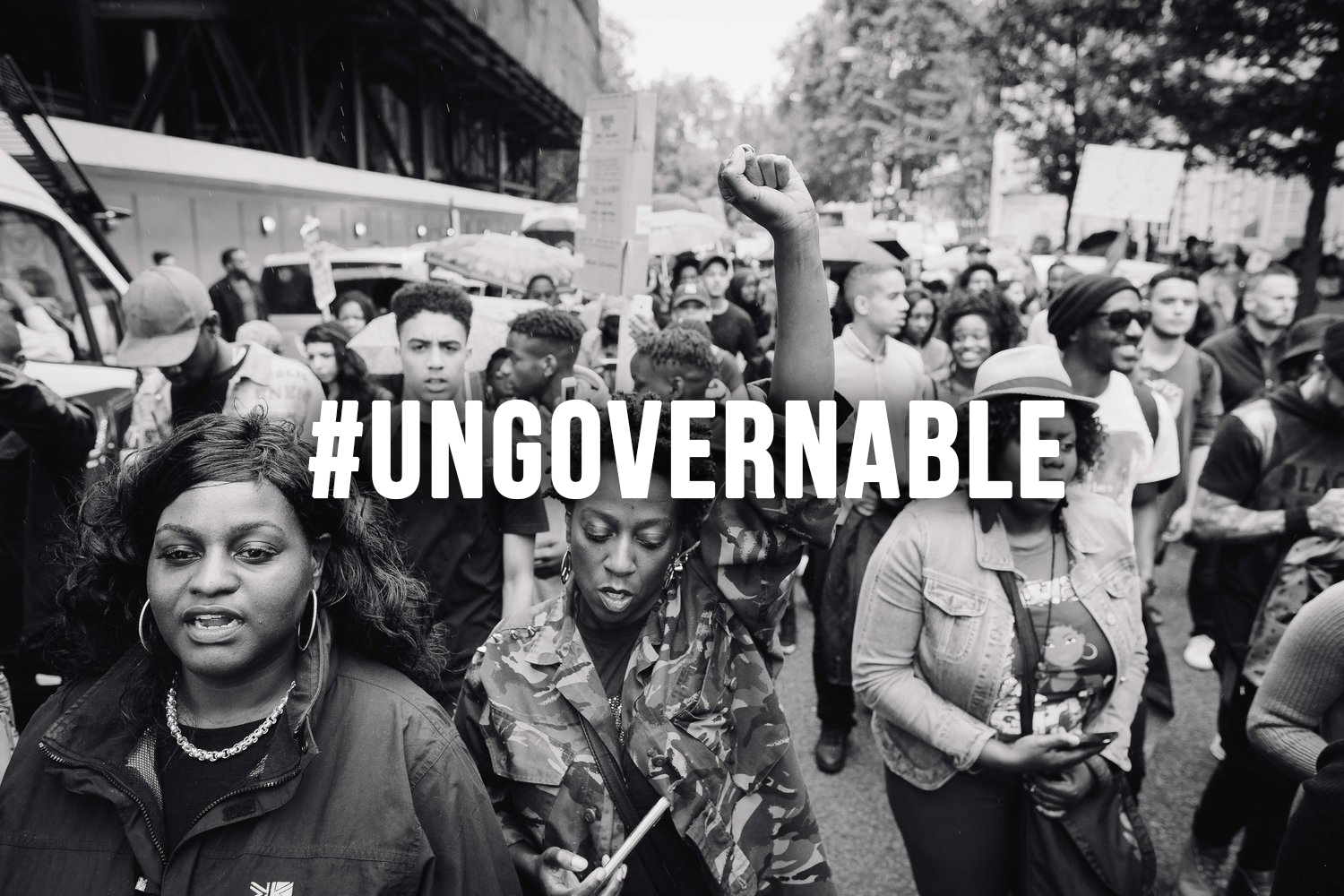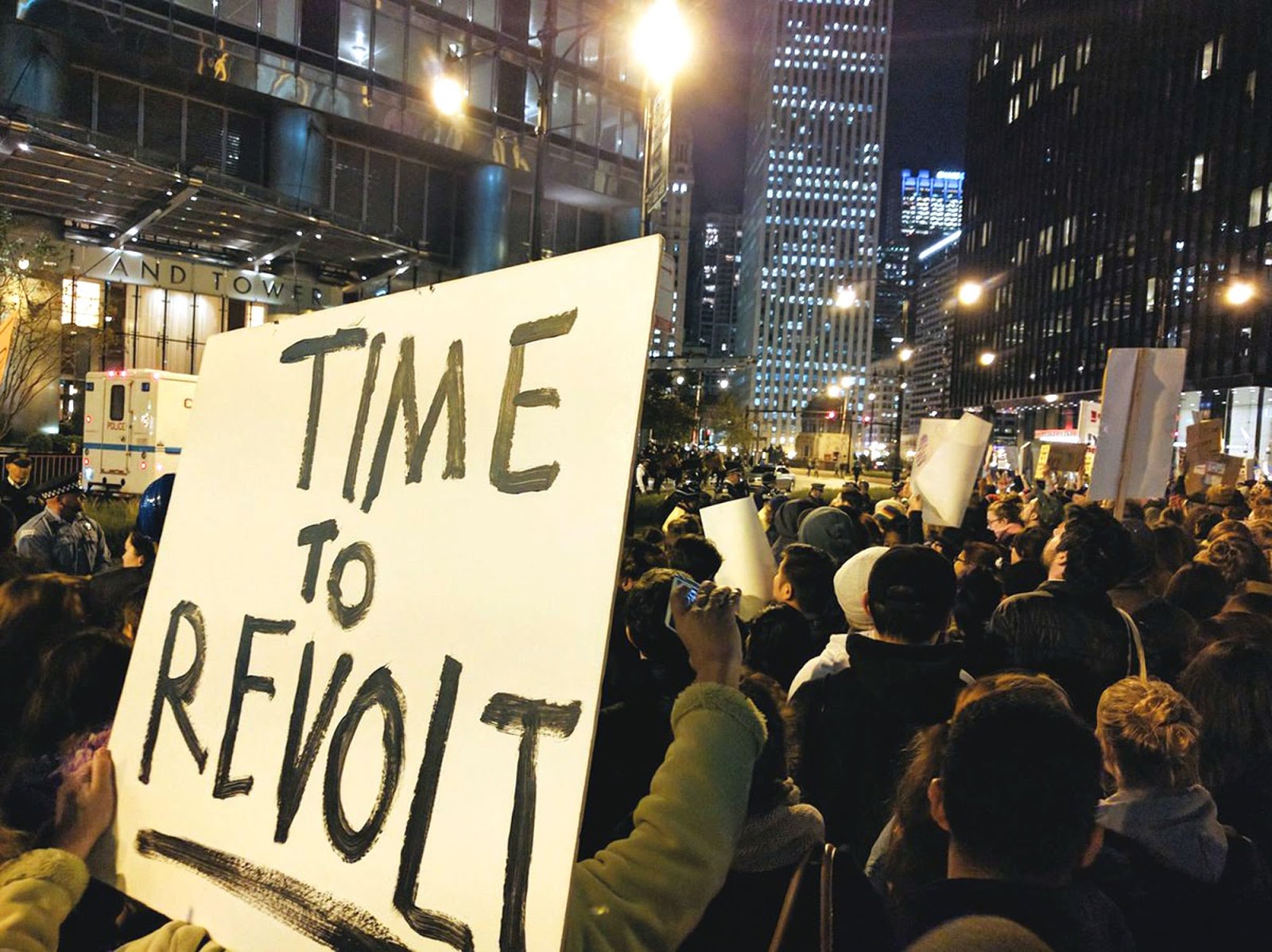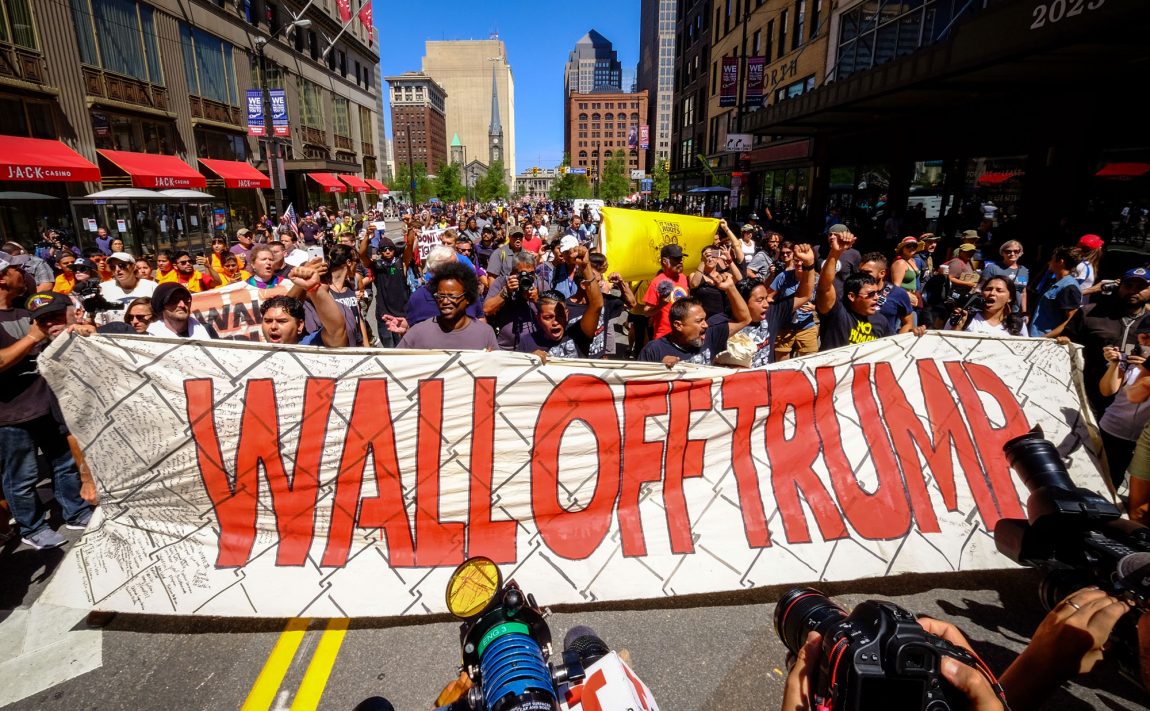 |
.
Given the nature of Trump’s politics and how he came to power, comparisons
abound between him and Hitler. Some of these comparisons are compelling; several
are strategically and tactically instructive for our present predicament. But,
while most activists focus on how and why Trump captured the Presidency, or the
nature of an ascending neo-Confederacy, most do not address the crisis itself.
Nor what the crisis practically implies, and when, where, and how the Left and
the people’s movements can and must intervene to produce desired outcomes.
The crisis in question is the crisis of the capitalist world system, which
has entered a profound state of economic and ecological imbalance, social
instability, inter-imperialist infighting, mass displacement, increased
suffering, and rampant carnage not experienced on this scale at a global level
since the 1930s. The crisis is rooted in the inherent contradictions of the
capitalist system, such as the tendency of the rate of profit to fall, the need
for constant expansion, uneven development within and between socio-political
units, and ecological externalization to name a few. The “Great Depression” of
the 1930s led to the second great inter-imperialist war, more commonly known as
World War II, which lasted from 1936 through 1945. The process of “creative
destruction,” which war under capitalism facilities, ended the depression and
ushered in a new era in the imperialist system, the era of U.S. hegemony.
The first 20 years of U.S. global domination was perhaps the greatest
period of sustained capital realization in the 400-plus year history of the
inhumane capitalist system. This exceptional period, from the mid-1940s through
the mid-1960s, was the product of successfully implementing world-system
regulating instruments crafted by U.S. imperialism to structure the process of
capital accumulation on a global scale, mediate inter-imperialist rivalry,
suppress and corrupt the national liberation and communist movements, and
contain the Socialist countries within the Cold War framework. The primary
instruments crafted by U.S. imperialism on the economic side were the Bretton
Woods institutions, consisting of the World Bank, the International Monetary
Fund (IMF), the General Agreement on Tariff’s and Trade (GATT), and its
successor the World Trade Organization (WTO). And grand recapitalization
initiatives like the Marshall Plan (which rebuilt the economies of Western
Europe after second Inter-Imperialist War). On the political side the primary
instruments crafted by U.S. imperialism were the United Nations (UN), the
European Union, and a host of regional instruments like the Organization of
American States (OAS), and all enforced by the North Atlantic Treaty
Organization (NATO).
Beginning in the 1970s, in the effort to restore profitability, capital
slowly rejected the Keynesian strategy of capital accumulation adopted in the
1930s and gradually adopted a cannibalistic strategy that focused on
privatizing public assets, destroying workers organizations and social
solidarity, commodifying as many social processes, interactions, and exchanges as
could be monetized, and the evisceration of the symbolic and false trappings of
western bourgeois democracy. This new strategy of capital accumulation is
typically called “neo-liberalism”. Neo-liberalism was first adopted wholesale by
the murderous Pinochet regime in Chile in the 1970s. It was forced wholesale
upon the world once it became the official strategy, ideological framework, and
statecraft of the Reagan regime in the 1980’s. It was instituted domestically
through the Volcker Shock at the Federal Reserve and the policies of
Reaganomics. And internationally it was primarily instituted through the IMF
and World Bank that imposed neo-liberal “structural adjustment programs” on all
the nations that suffered through the debt crisis of the 1980s.
As we know from history, nothing remains static. The neo-liberal strategy
of capital accumulation and class restoration began to lose both economic
momentum and political coherence in the late 1990s. The fragmentation started
with the Asian Financial Crisis and the Dot.com bubble implosion of the late
1990s. Despite the enormous amount of profit the neo-liberal corrective was
rendering to the trans-national capitalist class, all it was delivering to the
working class on a universal basis was shock, awe, and misery. From the late
1990s on, fewer and fewer of the social and political promises advanced by the
prophets of neo-liberalism could be met as the costs of maintaining the Bretton
Woods/UN/NATO system increasingly became a hindrance to capital accumulation.
Working class populations the world over were becoming poorer and poorer as the
race to the bottom being pursued by the trans-national capitalist class kept
tightening the screws trying desperately to realize a profit and maximum rates
of return on investment. This stimulated the development of several breakaway
political movements, like the anti-globalization movement, and state reform
efforts in Venezuela, Brazil, Ecuador and Nicaragua to name a few.
And then there was U.S. imperial overstretch to tip the scales. The
invasions and subsequent occupations of Afghanistan (2001) and Iraq (2003)
strained the resources of the U.S. government, weakened its military capacity,
and soured the credibility of the U.S. It also weakened financial markets around
the world, which resorted to ever larger and deeper extortion measures, like the
financial runs on Argentina, Uruguay, and Myanmar, and the eventual
cannibalization of international financial institutions during the collapse of
the housing bubble in 2007-2008, like Countrywide Financial, Northern Rock,
Bear Sterns, Wachovia and many others. The housing bubble burst caught the U.S.
government and the forces of trans-national capital flatfooted, resulting in the
so-called “Great Recession” and the fictitious recovery we are living through
now.
By every measure the world-system is set for another major global calamity,
but with even higher stakes given the depth of the climate and ecological
crisis produced by the exploit and plunder, expand-or-die capitalist mode of
production. The result? Given the present balance of forces throughout the
world, we are either facing another great inter-imperialist war that will result
in massive destruction and the likely creation of a new “pecking order” of the
capitalist world system as occurred in the 1940s. Or the global war will
produce no imperialist winners, but only result in dystopian barbarism, the
collapse of “civilization”, and the likely fulfillment of the 6th great
extinction event that many are coming to see as virtually inevitable.
 |
We have to ask ourselves, are there other options? Other possibilities?
And if there are, what must we do to bring these into being?
We have to start with a clear understanding that the “liberal” center of
the world-system is exhausted, bankrupt, and cannot hold. Resistance is growing
and is just beginning to develop a revolutionary imagination, and address the
imperative need for revolutionary organization and strategic focus. The
relatively spontaneous, reactive, and largely reform-minded movements we see in
North America and Europe, from the center-left (liberals and social democrats)
and the right, against the predominant neo-liberal order, reveals that there is
tremendous potential for change. However, the change will only be substantive
and beneficial to humanity if what replaces our present unethical and
inequitable world is truly emancipatory. Spontaneity will not get us there, nor
will the liberals, centrists, or the resurgent forces of the right. A
revolutionary force is needed, one that is not yet born.
We argue, that the salvation of the human family is up to us—the
revolutionary left and the people’s movements. We must find a way to align and
unite our fragmented forces and form a revolutionary, counter-hegemonic
force.
Some of the fundamental questions confronting emergent revolutionary forces
are how will the developing anti-capitalist and anti-imperialist struggle be
unified? How will the revolutionary political forces develop and struggle? And
where should and will they aim their strategic focus? As these forces develop
and struggle for political and strategic clarity, they will have to confront and
overcome the demons that have weakened revolutionary forces over the last
several hundred years—internal democracy, hierarchy, sexism, patriarchy,
heterosexism, Eurocentrism and settler-colonialism, white supremacy, xenophobia,
the mental/manual division of labor, electoral fixations, economism,
revisionism, and reformism. While all of these issues are of equal weight, the
last three issues are of particular short-term concern in the U.S. context,
because if the struggle against them is mishandled it will result in the emerging
resistance movement being subject to the forces and agenda of liberal faction of
U.S. imperialism, the Democratic Party.
So, the question, how do we play a leading role in facilitating and
directing the current motion of resistance and transform it into a revolutionary
movement, is paramount. The orthodox left's urging in times and conditions similar
to these has been to organize “popular,” “united,” or “national” fronts to unite all
who can be united in the struggle against fascism. But these calls rarely take
into account the inequality or lack of political parity of the “uniting” forces,
and have usually blurred or ignored the difference between the fundamental unity
required in strategic alliances and the temporary or limited unity of tactical
alliances. United fronts (in which all parties agree to subordinate or postpone
their “secondary issues”) are necessary to mount massive campaigns of resistance
against right-wing dictatorships and/or fascist regimes; but they have proven
woefully inadequate as vehicles of revolutionary social transformation. They are
therefore necessary tactically for defense, but insufficient for the purposes of
strategically advancing a revolutionary program.
At best, “united fronts” are instruments for restoring the status quo ante,
which in our case is the neo-liberal capitalist-imperialist order that has
dominated U.S. political economy since the 1980’s. The failure of this order
created the political vacuum that produced Trump and the resurgence of white
nationalism and neo-fascism. Restoring the failed neo-liberal order is no
solution. Nor is the attempt to campaign for the restoration of the welfare or
social democratic state a solution, as it to was (and is) a strategy to maximize
profits and pacify and disempower the working class, not one of social
liberation.
Many of the current liberal, progressive, and left-leaning discussions
about how to resist Trump and the neo-Confederates reflect the limitations of
this “united front” approach. Some, like Sanders and Nader, project a
combination left-right unity for economic collaboration with the emerging
neo-fascist regime. Others, like Nancy Pelosi, say “the country can withstand
the election of Donald Trump,” why it's important to take a breath and why, she
says, Democrats are doing the Lord's work.
Other democratic pundits strike a laissez-faire “populist” tone,
exemplified by the “Wait for the Government to Collapse and then your in Power”
article in Politico, saying “the most likely outcome of this Republican
government is probably failure, which is a horrible thing for the country but
actually a very convenient one for the Democratic Party. So follow that
strategy, disassociate yourself from the outcomes, wait for the government to
collapse and then you’re in power again.” It’s the old mad illusion of
democratic pendulum swings, but with a caveat: “this is bad for the country and
the way things go badly might result in horrific tragedies, so that’s a grim
prospect, but if you’re simply analyzing the political calculation, that’s
available to the Democrats. . . . at times they’re going to have to balance their
political interests against policy outcomes. So if you have a chance to bargain
with the Trump regime, in a way that averts humanitarian catastrophe, you could
trade away some of your political leverage to do so, to negotiate minor details
on Obamacare so that you can avoid subjecting millions of people to hardship,
then that’s probably worth doing. Climate would be another area where that kind
of bargain is worth doing—giving them bipartisan cover in order to mitigate the
damage of the policy agenda. But otherwise, if you’re just analyzing what’s in
the political best interest, it’s almost never to cooperate.”
Such arguments are promoted by liberal Democratic figures and echoed by
reform-careerists, in order to hold more privileged “middle-class” folks to a
loyalist agenda, and in order to silence more radical and demanding activists
and critics. In other words, Democrats should ride the discontent and direct it
toward non-involvement with Trump initiatives so the pendulum will swing back
mechanically to the Democratic Party retaking power. Many will, (unfortunately
in this view) be thrown under the bus—"for the common good."
This argument appeals to the reform left who, long accustomed to playing
the single-issue reformist game a la “NGOism,” will fit right in and help
throw radicals and all manner of anti-system activists—like those struggling
against the police, prisons, poor education, inadequate health and childcare,
substandard and unaffordable housing, gentrification, domestic violence,
anti-surveillance, whistleblower, animal rights, transphobia, climate justice,
Islamophobia, BDS, anti-fascism, etc.—under the bus for “the greater good,” so
as not to spoil the “strategic deal” of a projected pendulum reversal.
 |
But the views of the millions "thrown under the bus" historically and
today are not unknown, though routinely denied, dismissed, deemed divisive, and
often outright criminalized. Many activists are easily swayed by such arguments,
in part because of decades of single-issue reformism, and also the utility of
commonplace appeals to “united fronts” historically, which have not been
critically examined. In times of great capitalist crisis, severe systemic
repressions combined with age-old oppressions throw many people on the
defensive and often move many to be dismissive of attempts at revolutionary
challenges to the system. In such a time it’s crucial to examine these illusory
“pragmatic” maneuvers (surrenders) against the reality, from the perspective of
those who have been, and will be, thrown under the bus—the unmentionables and
untouchables throughout the US political arenas.
We have to counter the narrowness of the standard “united front” approach
and build a political force and a social movement that aims for social and
economic emancipation, and not just a restoration of the “good ole bad days” of
the Obama era or the 1950s and 60s. This force must be built by the broad
totality of the working class in all of its (ethnic, racial, national,
spiritual, and gender) diversity, serve its broad interests, and be
self-organized and self-directed. By working class, we do not mean a narrow,
monolithic subject of the AFL-CIO trade union ideal—the old, idealized, white,
heterosexual, male-bodied, industrial worker. The working class encompasses all
those who are structurally dispossessed from owning and controlling the means of
production, and who are dependent upon selling their labor, labor power, or
their bodies and reproductive capacity in order to survive. This includes
everyone from computer programmers to sex workers, from teachers and
wage-slaved doctors (both traditional and alternative) to farm workers, from
prisoners to the structurally unemployed, and to the vast numbers of
unrecognized “gray market” workers in household, caregiving, home and auto
maintenance, food preparers, and others. Given the increasing automation of
production, this force must call for and organize a liberatory program based on
the decolonization of land and knowledge systems, the democratization of the
productive forces, the full automation of the productive forces, the
decarbonization of the economy, the full democratization of markets and the
processes of value exchange, and a regenerative social order based on zero-waste
the restoration of the biosphere.
This is not a vision and a program that can be led and advanced by a
narrowly focused “united” or “popular” front and the convoluted class-interests
that such unequal alliances represent. Given the urgency of the situation,
particularly from an ecological perspective, the universal interests of the
working class cannot be entrusted to and constricted by liberal bourgeois forces
of privilege, who historically tend to dominate popular and united fronts with
their positionality and resources, and who often intentionally work to dilute
and obscure the politics of struggle for social (class, national, racial,
sexual, and gender) liberation in order to sustain their position and preserve
the bourgeois order.
The key to understanding and acting in a revolutionary manner in a period
of profound social instability and upheaval is to recognize and rally forces to
the strategic emancipatory opportunity, even while uniting broadly for defense
against the serious threats and attacks. The fragmentation of power, of social
hegemony, means that there is space for revolutionary interjection,
intervention, and innovation from subaltern class forces. What we lack is the
organization, resources, and initiative to intervene in a sustained and determined
manner. But, these are not normal times, and the opportunities to create the
means of seizing the initiative can be found and created. Capitalism is driving
humanity and all complex life on earth to the brink of extinction. Trump, the
Tea-Party neo-Confederates, and the rising neo-Fascist forces throughout the
world are just a reflection of this dynamic of collapse. The situation demands
that we, the Left and the People’s Movements, rise to the occasion. Although
profoundly difficult, history says we can. Let us make this era the most
luminous period in human history.
We can.
We must.
We will.